Sunday, 23 June 2019
Distance 24 km
Duration 7 hours 5 minutes
Ascent 520 m, descent 600 m
We had hardly spoken a word of French since arriving in Liginiac, and the morning was no different in this regard. We crept out of the sepulchral camping ground, where everybody was dreaming in Dutch, down past the sign for the Méridienne Verte, and up the main street to our English-speaking breakfast hosts.
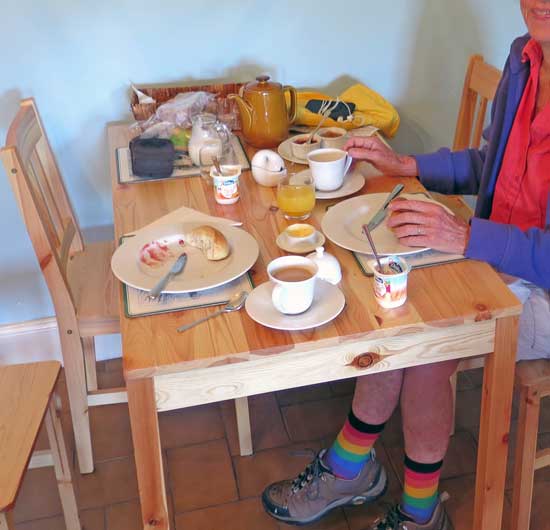
At Dreamcatcher House they were expecting us. Two tables were set indoors and we occupied the smaller one. There were noises from above, which caused Justine to switch off the overhead chandelier, explaining rather crossly that the children upstairs were shaking the floor so much that it might break the light bulbs.
When the family appeared for breakfast they looked very meek and mild – a bespectacled father, plain-faced mother and two quiet black-haired children. Justine’s accent when she spoke French was so excruciating that it was almost a parody, but they seemed to understand her. Somehow, this deterred me from trying out my French on them.
Meanwhile we cleaned up all the pastries, bread and coffee on the table, and were very pleased when Alan appeared with a large parcel of lunch food for us – four bread rolls filled with paté and salad, plus two wedges of tarte.
He was worried, sweet man, that we would not find anywhere to eat on our journey today. As it turned out, this food lasted us for two lunches and half a dinner.

Setting off with many thanks to our kind hosts, we strolled up out of the town and reached the top of the rise, where we turned off on the D42e, as satisfactorily small as its name suggested, and began to descend slightly, through rich, undulating farmland.
As well as grazing cows, there were a great many high-tension power lines radiating in rigid straight lines from a huge electrical substation, out of which power from the hydro plant on the river below was distributed. Next to this gaunt substation were the remnants of the pleasant village of Marèges.
We walked on for a couple of kilometres, still high above the river, and came to a wheel track going off into the forest.
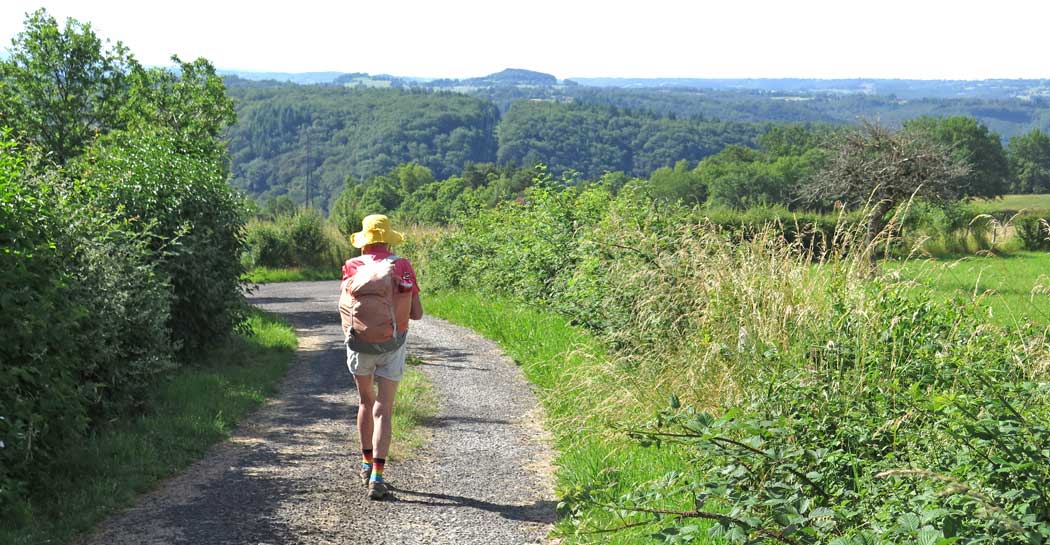

At this point we were only about 600 metres from the bridge over the Dordogne that we were heading for (the bridge of Vernéjoux), but on our map the track stopped before the final hundred metres, the part which was black with contour lines.
We were tempted to risk it but managed to resist, and that was a good move, because when we got to the bridge much later, there was no possibility of a track coming down the sheer face of the gorge at that place.
The road began to drop and we entered a forest, then joined another road, coming from Sérandon, and started the descent in earnest.
This fast-falling road was carved directly out of the cliff face, and a lot of dynamite had evidently gone into its construction, although it looked old.

The steeper and more exposed sections were edged by low stone walls, and occasionally we glimpsed through the forest an expansive view of the valley of the Dordogne below us.
As it was Sunday morning, there were a lot of amateur cyclists, dressed like professionals, toiling up the hill, and one plump matron who was not toiling at all – she sailed past on an electric bike.
It took about half an hour on this road to reach the bridge, but it seemed longer, as we were in the full sun most of the time, and not sure what the next section, the climb up the other side, was going to be like.

The river at the bridge was hardly more than a trickle, not the majestic waterway that we had imagined, and we realised later that the Marèges hydro station just upstream had stolen most of the water. There was only one house at the bridge, backed up against a fearsome cliff.
As we crossed the river we left the department of Corrèze and entered Cantal, a department that we had never set foot in before.
On the other side we looked for the GRP that, according to our map, would save a great amount of trudging up the road, and we found it easily enough, but it was a fearsome sight – a steep, eroded trough full of stones, mud and tree roots, flanked on the right by a gaping drop to a stream.

But there were branches to haul ourselves up on, so it was safe enough, and after a while we stopped for lunch, perched perilously on a large boulder.

Two of Alan’s paté and salad rolls went down very well, and we climbed onwards, only to discover that we were almost at the top already. The first indication was the sight of a cleared field above us through the trees.

Our rough, ladder-like track turned sharply, crossed the stream and flattened to a much easier gradient, with a mossy stone wall beside it, which was certainly several centuries old, indicating that this was a former main route.
It widened into a wheel track and we emerged from the forest into gently sloping farmland.
Then there were scattered houses, and after a bit more climbing on a bitumen road, we arrived at the village of Champagnac, ready for refreshments.

There was a bar, but annoyingly it was closed, whether for the afternoon or permanently we could not tell, and it was the same with the boulangerie, so we sat rather dispiritedly under a tree near the war memorial.
The only amenity that was useful to us was the nearby public WC, where we refilled our water bottles at the hand basin.
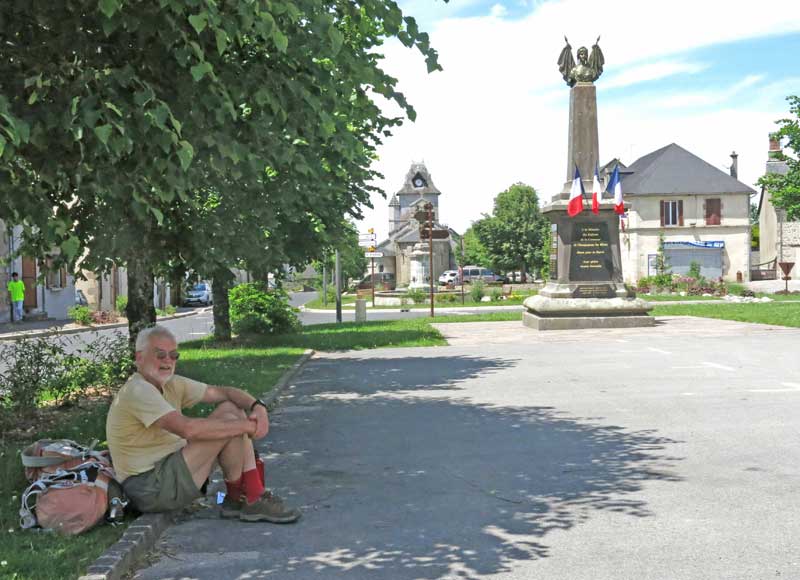
There followed an hour of plodding along a hot tar road to get to the bigger town of Ydes, where we had decided to stay in the hotel (there was no camping ground there).
We were feeling the worse for our exertions and the heat, and did not relish pushing on to Saignes.
The other advantage of staying in Ydes was that it would avoid several kilometres of extra walking tomorrow.
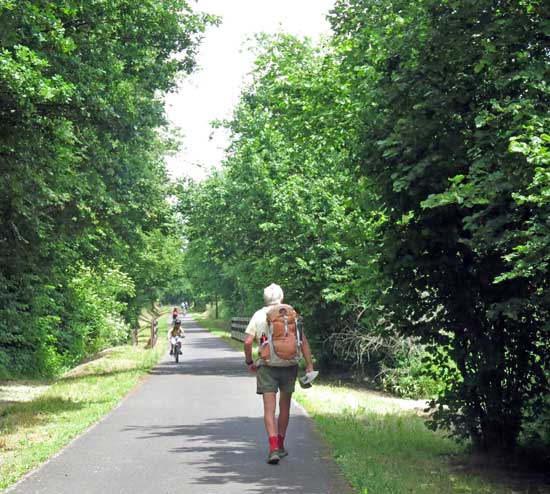
However, once again we were disappointed – the hotel was defunct. The consolation prize was an open bar, at which we had a cold Orangina before setting off for Saignes, four or five kilometres further on.
Half the distance was on a former railway line, now a cycle path, and we would see more of this the next day.
When we got to the remains of the station, we veered off on a gravelly wheel track that climbed around the flank of a wooded hill, and came down through meadows into the village, which looked promisingly neat and well-to-do.
The camping ground was supposed to be next to the swimming pool and the sports grounds, and it was, but it consisted of a stretch of long, derelict dry grass behind a locked gate.
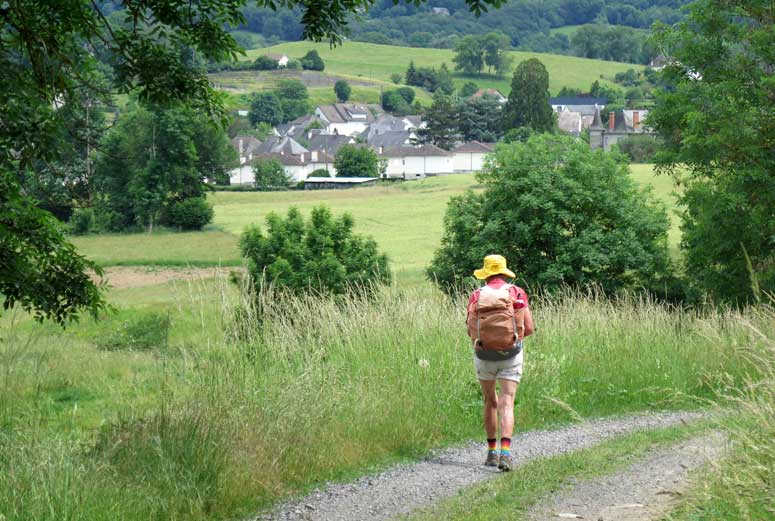
Our prospects for accommodation were starting to be a worry, and we briefly considered just pitching our tent on the dry grass for the night, but the prospect had no appeal at all, for me at least. I get scared at night in places like that.
A couple of streets further on we arrived at the centre of town, and it was charming. The church square, with its war memorial and double row of plane trees, was lined with shops, including a busy, lively bar, where we immediately sat down and ordered coffee and cold water.
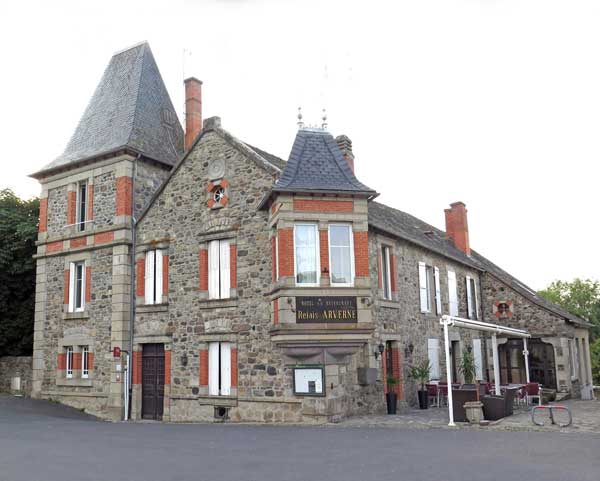
A few doors down the street there was a hotel, a whimsical grey-and red edifice with towers and turrets, called the Relais Arverne (we recognised the reference to the Gaulish tribe of the Arverni).
Tables were set out on a terrace beside it but they were empty except for one old drunkard, who assured us that the owner would return in due course. We went back and continued sitting at the bar, going down to the hotel every now and then to try the doorbell.
On about the fourth attempt, the door opened and a small, gingery man said that we could have a room, but that the restaurant was closed on Sundays. However there was another bar, behind the church, where we could have dinner. This was excellent news.
Our room looked out away from the street, onto green meadows and the wooded hill that we had crossed on our way here.

The shower was magnificent, and after we had made the usual mess with our dangling wet washing, we cast ourselves down with the window flung wide, and enjoyed the relief of having all our problems solved for the day.
At about 7:30 we stepped out into the street and had glasses of cold rosé at the bar, which was still bustling, then strolled on past the fine, slender old church at the end of the square, and found, rather to our surprise, that our host was right – there was indeed another establishment there, the Café de la Poste, which described itself as a Brasserie/Pizzeria, but seemed to have only pizzas on the menu.
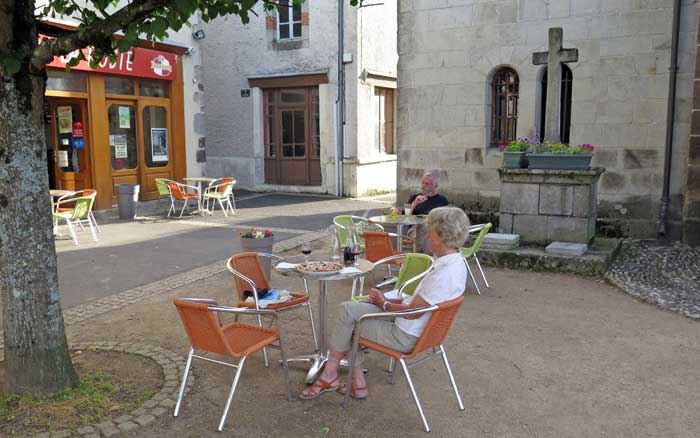
They were doing a brisk trade in take-away pizzas, but there were also tables set out on the gravel forecourt at the east end of the church, under a canopy of trees. The drunkard that we had talked to earlier was sitting at one of the tables, and we saw him again later, at the other bar – he obviously shared his favours around.
We ordered a vegetarian pizza, which was loaded with all sorts of vegetables and was delicious.
In France we find that a whole pizza each is too much for us, possibly because our stomachs shrink when we walk so much. In this case we had some spare capacity after sharing one, so we went back to the hotel and ate the sweet tarte that our host Alan had given us this morning in our lunch bag. There were still two paté-and-salad rolls remaining for another day.
Previous day: Ussel to Liginiac